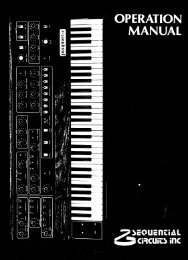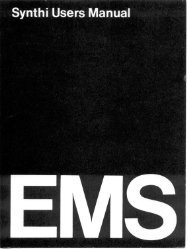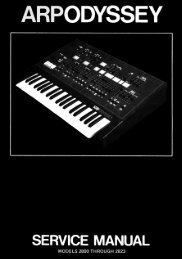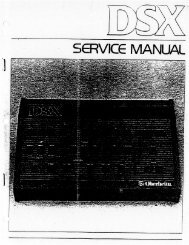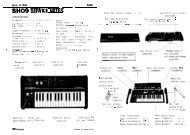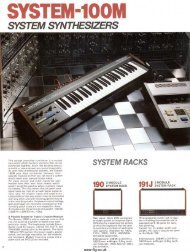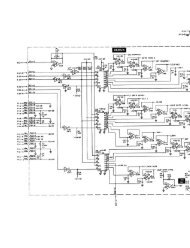ARP2600 - Fundamentals of Music Technology - Cyborgstudio.com
ARP2600 - Fundamentals of Music Technology - Cyborgstudio.com
ARP2600 - Fundamentals of Music Technology - Cyborgstudio.com
You also want an ePaper? Increase the reach of your titles
YUMPU automatically turns print PDFs into web optimized ePapers that Google loves.
078 - SECTION TEN: S/H MODULEYet another wonderful possibility is to connect a control source, such as an LFO to jack C, and thenconnect jacks A and B to the FM inputs on two different oscillators. When the outputs <strong>of</strong> these oscillatorsare brought up in the filter and sent to the mixer, the two will be alternately modulated. CD track 52Another favorite technique is to connect the output <strong>of</strong> the last module in a patch to jack C, and connectone <strong>of</strong> the two remaining jacks to the mixer. In this configuration, the switch will switch between thepatch and silence which creates a wonderful pulsing sound. When <strong>com</strong>bined with a resonant filtersweep, this creates a sound which is very popular in today’s dance music. This sound can be heard onCD track 53.Switching patches are also very interesting and useful. It is possible to connect two different oscillators,perhaps tuned together but producing different timbres to jack A and B, and the electronic switch willswitch between the two. It is even possible to switch between two different waveform outputs <strong>of</strong> oneoscillator in this way.Two sound sources tuned to different pitches can also be connected to jacks A and B, and the electronicswitch will switch between the two. The switch could also be used to switch between tuned oscillatorsand the noise generator’s output. Examples <strong>of</strong> these techniques can be heard on CD track 54. Alternately,two different versions <strong>of</strong> the same sound (filtered and unfiltered for example) could be connectedto jacks A and B and the electronic switch will switch between the two.Again, the electronic switch is not just for audio signals. It can also be used to switch between differentcontrol signals as well. On the most basic level, the electronic switch could be used to flip between twodifferent waveforms from an LFO in an FM patch. Or, the switch could be used to flip between twodifferent LFO’s modulating one VCO. Perhaps one LFO could be in the audio range while the other isin the sub audio range. Examples <strong>of</strong> this technique can be heard on CD track 55.THE SAMPLE-AND-HOLD UNITThe sample-and-hold unit (<strong>of</strong>ten abbreviated S/H) employs a series <strong>of</strong> fairly simple concepts to generatea useful control voltage. There are several steps to its operation, the first <strong>of</strong> which is sampling.Sampling basically means taking a measurement. The S/H module samples voltage <strong>com</strong>ing into theS/H input which is the top most jack. In Figure 10-2 on page 75, one can see that the noise generator’soutput is normalled to it, and the label to the right side says SAMPLE & HOLD. Like most <strong>of</strong> theARP’s inputs, there is a slider which allows the user to attenuate the level <strong>of</strong> signal <strong>com</strong>ing into thisjack. The slider labeled LEVEL attenuates the in<strong>com</strong>ing signal.If a slow-moving saw wave is sampled, the S/H module might take samples every half second or so.The point at which the S/H module sampled is indicated in purple in Figure 10-3 on page 79. Noticethat the module takes samples at evenly spaced intervals. In this example, the S/H unit might take thefollowing readings <strong>of</strong> in<strong>com</strong>ing voltages for the saw wave in Figure 10-3: 0.6 volts, 1.4 volts, 2.5 volts,3.6 volts, 4.4 volts, 5.6 volts, 6.4 volts, 7.5 volts, 8.6 volts, 9.4 volts, and finally 9.8 volts at the top <strong>of</strong>the saw wave.




